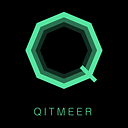In-Depth Guide to the QNG Block Explorer & API
In the crypto space, Qitmeer Network stands out as a pioneering and secure public blockchain. If you’re interested in exploring its technology, learning how to use the QNG Block Explorer and API is a great starting point. Whether you’re a crypto enthusiast or a developer looking to innovate in the digital currency space, this guide provides a comprehensive overview to help you master the QNG Block Explorer and its API effortlessly.
QNG Block Explorer: Access Real-Time Blockchain Data
The QNG Block Explorer is a blockchain data query tool that allows users to view real-time information on the Qitmeer Network. With this explorer, you can browse, search, and verify transaction details, block height, and $MEER (EVM) address balances. Additionally, the explorer helps you track transaction history, ensuring the security of your $MEER (EVM) assets.
How to Use the QNG Block Explorer?
Using the QNG Block Explorer is simple — just visit the explorer and enter a transaction hash, address, or block number in the search bar to retrieve relevant data. You can:
- Track your $MEER (EVM) transactions to ensure fund security.
- Verify transactions made by others.
- Check $MEER (EVM) address balances.
- View network-wide transactions, miner rewards, and other key insights.
This transparent and secure system provides users with a reliable and traceable transaction experience.
QNG API: A Powerful Tool for Developers
Blockchain APIs allow developers to interact with the blockchain seamlessly, retrieving data and functionalities without setting up a full blockchain node. The QNG API, designed for the Qitmeer Network, supports:
- Querying blocks, transactions, addresses, and balances
- Fetching details like transaction fees, inputs/outputs, confirmations, and timestamps
How to Use the QNG API?
Qitmeer Network has integrated BlockScout, enabling API access to transaction data. For example:
https://qng.qitmeer.io/api?module=account&action=txlist&address={addressHash}&startblock=1900000&endblock=2000000&page=1&offset=5&sort=ascIn this request, replace {addressHash} with the wallet address you want to query. The API will return a list of transactions within the specified block range. You can adjust parameters to fetch additional data as needed.
- 📌 For more API operations, visit the QNG API
QNG API Functional Examples
1. Retrieve Contract Address Information
Query ERC-20 or ERC-721 token details using a contract address.
📌Example API request for $WMEER:
2. Fetch Token Supply by Contract Address
Retrieve token supply data for ERC-20, ERC-721, and ERC-1155 tokens.
📌 Example API request for $DIM supply:
3. Get the Total Number of Token Holders
Fetch the total number of holders for a specific token.
📌 Example API request for $MEER (EVM) total holders:
4. Fetch Address Transaction Details
The caller can quickly obtain transaction records.
📌 Here is an example API for obtaining transaction details:
Conclusion
The QNG Block Explorer & API provide users with a gateway to explore the Qitmeer Network. With the block explorer, you can easily track $MEER (EVM) transactions and access real-time blockchain data. Meanwhile, the QNG API empowers developers to build customized blockchain applications, unlocking new possibilities in the digital currency ecosystem.
🦉Source: https://qitmeer.io/blogs/292
